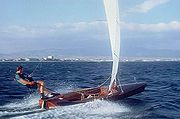.gif)
Planing (sailing)
Encyclopedia

History
The earliest documented planing sailboat was a proaProa
A proa, also seen as prau, perahu, and prahu, is a type of multihull sailing vessel.While the word perahu and proa are generic terms meaning boat their native language, proa in Western languages has come to describe a vessel consisting of two unequal length parallel hulls...
built in 1898 by Commodore Ralph Munroe; it was capable of speeds of more than twice the hull speed
Hull speed
Hull speed, sometimes referred to as displacement speed, is the speed of a boat at which the bow and stern waves interfere constructively, creating relatively large waves, and thus a relatively large value of wave drag...
.
Planing a sailing dinghy
Dinghy sailing
Dinghy sailing is the activity of sailing small boats by using five essential controls:* the sails* the foils ....
was first popularised by Uffa Fox
Uffa Fox
Uffa Fox CBE was an English boat designer and sailing enthusiast.-Life:Uffa Fox was born on the Isle of Wight and was raised in East Cowes. He lived for a while in Puckaster on the Isle of Wight.-Work:...
in Britain. In 1928 Uffa Fox introduced planing to the racing world in his International 14 dinghy, the Avenger. It had been designed with a hull shape which permitted planing. He gained 52 first places, two seconds and three third places out of 57 race starts that year.
Obviously this performance had an impact: other designers took on his ideas and developed them. Over the years, most dinghies have acquired some ability to plane, and there are now many high-performance dinghies (usually called skiffs, see these examples, or these in http://www.skiff.org.nz/), which will plane even in light winds, at all points of sail.
How planing works
When it is at rest, a vessel's weight is borne entirely by the buoyant force. At low speeds every hull acts as a displacement hull, meaning that the buoyant force is mainly responsible for supporting the craft. As speed increases, hydrodynamic lift increases as well. In contrast, the buoyant force decreases as the hull lifts out of the water, decreasing the displaced volume. At some speed, lift becomes the predominant upward force on the hull and the vessel is planing.Beginning to plane is the nautical equivalent of an aeroplane
Fixed-wing aircraft
A fixed-wing aircraft is an aircraft capable of flight using wings that generate lift due to the vehicle's forward airspeed. Fixed-wing aircraft are distinct from rotary-wing aircraft in which wings rotate about a fixed mast and ornithopters in which lift is generated by flapping wings.A powered...
breaking the sound barrier
Sound barrier
The sound barrier, in aerodynamics, is the point at which an aircraft moves from transonic to supersonic speed. The term, which occasionally has other meanings, came into use during World War II, when a number of aircraft started to encounter the effects of compressibility, a collection of several...
. The aeroplane at Mach
Mach number
Mach number is the speed of an object moving through air, or any other fluid substance, divided by the speed of sound as it is in that substance for its particular physical conditions, including those of temperature and pressure...
1 essentially catches up with the compression waves ahead of it, which coalesce into a shock wave
Shock wave
A shock wave is a type of propagating disturbance. Like an ordinary wave, it carries energy and can propagate through a medium or in some cases in the absence of a material medium, through a field such as the electromagnetic field...
.
Although any hull will plane if enough power is provided and enough speed is attained, a hull designed for operation in the planing realm is sometimes distinguished by a flat run aft. In other words, in side view, the bottom is more or less a straight line towards the stern. (Exceptions to this include surfboard
Surfboard
A surfboard is an elongated platform used in the sport of surfing. Surfboards are relatively light, but are strong enough to support an individual standing on them while riding a breaking wave...
s and other recreational planing hulls, which utilize rocker throughout for enhanced maneuverability when banking through turns.) In contrast, in a displacement, or non-planing hull, the bottom is curved in side view (the curvature is called "rocker") all the way from bow to stern, in order to minimize wave drag. In front view, the sections in the aft area may be straight, as in a racing hydroplane, to maximize planing forces and speed, but for practical reasons of stability and comfortable ride are often V-shaped, especially in boats intended for offshore use.
To plane, the power-to-weight ratio must be high, since the planing mode of operation is quite inefficient; sailing boats need a good sail area and powerboats need a high-power engine. Most surfboard
Surfboard
A surfboard is an elongated platform used in the sport of surfing. Surfboards are relatively light, but are strong enough to support an individual standing on them while riding a breaking wave...
s are planing or semi-planing hulls that utilize the push of the waveform more or less in combination with gravity to achieve planing lift.
Techniques used to promote planing in a sailing boat
.jpg)
- Sailing on a reach or broad reach to begin
- Raising the centreboard or daggerboard
- Keep the hull level, trapezeTrapeze (sailing)In sailing, the trapeze refers to a wire that comes from a point high on the mast, usually where the shrouds are fixed, to a hook on the crew member's harness at approximately waist level...
if necessary
in addition to these:
- Moving the crew weight increasingly towards the rear to begin and to sustain planing
- Flicking or pumping the sails (although there are restrictions on doing this in a race)
While planing, it is important to steer through the waves, avoiding any collision with the wave in front.

